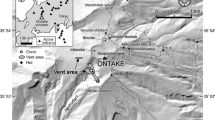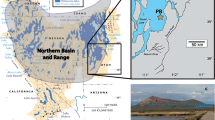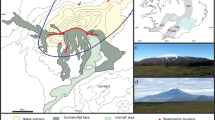Abstract
We have recognized a type of pyroclastic deposit formed by the interaction of water and silicic magma during explosive eruptions. These deposits have a widespread dispersal, similar to plinian tephra, but the overall grain size is much tiner. Several deposits studied can be associated with caldera lakes or sea water and water/magma interaction is proposed to account for the fine grain size.
Several examples have been studied, including the Oruanui Formation, N.Z., and the Askja 1875 deposit. Both show little downwind decrease in median diameter, a downwind decrease in sorting (σφ) (more evident in the Askja deposit) and coarse tail grading. The Askja example has base surge deposits near source and some Oruanui members show multiple thin beds near source; both are common features of phreatomagmatic deposits. Isopachs of the Askja deposit indicate a source under Lake Oskjuvatn in Askja Caldera and those of the Oruanui indicate a source under the NW part of Lake Taupo.
In terms of dispersal area, volume and calculated eruption column heights, these deposits are similar to plinian. However, their extreme fragmentation due to magma/water interaction, superimposed on fragmentation imparted by carlier vesiculation, gives a much finer and more complex grain size distribution than plinian counterparts. The field of phreatomagmatic equivalents to plinian pumice deposits was unoccupied onWalker’s (1973) classification of explosive volcanic eruptions. Such deposits are the phreatomagmatic analogue of plinian deposits and the name « phreatoplinian » is proposed.
Similar content being viewed by others
References
Aramaki, S., 1975,Classification and Mechanisms of Volcanic Eruptions. Bull. of Volc. Soc. Japan,20, p. 205–221.
Bennett, F. D., 1972,Shallow Submarine Volcanism. J. Geophys. Res.,77, p. 5755–5759.
Blackburns, E. A., Wlson, L. andSparks, R. S. J., 1976,Mechanisms and Dynamics of Strombolian Activity. J. Geol. Soc. Lond.,132, p. 1–16.
Booth, B. andWalker G. P. L., 1973,Ash Deposits from the New Explosion Crater, Etna 1971. Phil. Trans. R. Soc. Lond.,274, p. 147–151.
—————, andCroasdale, R., 1978,A Quantitative Study of Five Thousand Years of Volcanism on São Miguel. Azores. Phil. Trans. R. Soc. Lond.,288, p. 271–319.
Colgate, S. A. andSigurgeisson, T., 1973,Dynamic Mixing of Water and Lava. Nature,244, p. 552–555.
Crowe, B. M. andFisher, R. V., 1973,Sedimentary Structures in Base Surge Deposits with Special Reference to Cross-bedding, Ubehebe Craters, Death Valley, California. Geol. Soc. Am. Bull.,84, p. 663–682.
Escher, B. G., 1933,On a Classification of Central Eruptions According to Gas Pressure of the Magma and Viscosity of the Lavas. Leids. Geol. Mededel.,6, p. 45–49.
Fisher, R. V., 1964,Maximum Size, Median Diameter, and Sorting of Tephra. J. Geophys. Res.,69, p. 341–355.
Hahn, G., Rose W. I. andMeyers T.,Genetically Related Rhyolitic Ash Flow and Air Fall Tuffs, Gentral and Western Guatemala and the Equatorial Pacific. (in press).
Healy, J., 1964,Stratigraphy and Chronology of Late Quaternary Volcanic Ash in Taupo, Rotorua and Gisborne Districts. N.Z. Geol. Surv. Bull.,73, part I, p. 1–42.
Heiken, G. H., 1971,Tuff Rings: Examples from the Fort Rock — Christmas Lake Valley Basin, South Central Oregon. J. Geophys. Res.,76, p. 5615–5626.
—————, 1974,An Atlas of Volcanic Ash. Smithsonian Contrib. to Earth Sci. No. 12, Smithsonian Institution Press, Washington, DC, 100 pp.
Huang, T. C., Watkins N. D. andShaw D. M., 1974,Atmospherically Transported Volcanic Glass in Deep-Sea Sediments: Development of Separation and Counting Technique. Deep-Sea Res.,79, p. 3057–3071.
Inman, D. L., 1952,Measures for Describing the Size Distribution of Sediments. J. Sed. Petrol.,22, p. 125–145.
Knox, J. B. andShort N. M., 1964,A Diagnostic Model Using Ash Fall Data to Determine Eruption Characteristics and Determine Eruption Characteristics and Atmospheric Conditions During a Major Volcanic Event. Bull. Volcanol.,27, p. 5–24.
Kohn, B. P., 1973,Some Studies of New Zealand Quaternary Pyroclastic Rocks. Unpub. Ph.D. Thesis, Victoria University, Weilington, New Zealand.
Lewis, K. andKohn B. P., 1973,Ashes, Turbidites, and Rates of Sedimentation on the Continental Slope off Hawkes Bay. N.Z. J. of Geol. and Geophys.,6, p. 439–454.
Lirer, L., Pescatore T., Booth, B. andWalker, G. P. L., 1973,Two Plinian Pumice-Fall Deposits from Somma-Vesuvius, Italy. Geol. Soc. Am. Bull.,84, p. 759–772.
Lorenz, V., 1974,Vesiculated Tuffs and Associated Features. Sedimentology,21, p. 273–291.
Machado, F., Parsons, W. H., Richards, A. F. andMulford, J. W., 1962,Capelinhos Eruption of Fayal Volcano, Azores, 1957–1958. J. Geophys. Res.,67, p. 3519–3529.
McBirney, A. R., 1963,Factors Governing the Nature of Submarine Volcanism. Bull. Volcanol.,26, p. 455–469.
Milne, D. J., 1975,Quaternary Geology of the Rangitikei River Valley, New Zealand. Unpub. PhD. Thesis, Victoria University, Wellington, New Zealand.
Moore, J. G., 1967,Base Surge in Recent Eruptions. Bull. Volcanol.,30, p. 337–363.
—————, 1975,Mechanism of Formation of Pillow Lava. Am. Sci.,63, p. 269–277.
Peckover, R. S., Buchanan, D. J. andAsilley, D. E. T. F., 1973,Fuel-Coolant Interactions in Submarine Volcanism. Nature,245, p. 307.
Pullar, W. A., 1973,Maps of Isopachs and Volumes of Tephra, Central North Island, New Zealand, 1:1,000,000. New Zealand Soil Bureau Maps 133/8–14, to accompany New Zealand Soil Survey Report 1.
Schmincke, H.-U., Fisher, R. V. andWaters, A. C., 1973,Antidune and Chute and Pool Structures in the Base Surge Deposits of the Lacher See area, Germany. Sedimentology,20, p. 553–574.
Schmincke, H.-U., Fisher, R. V. andWaters, G. P. L., 1974,The 1973 Heimaey Strombolian Scoria Deposit, Iceland. Geol. Mag.,111, p. 539–548.
Shaw, D. M., Watkins, N. D. andHuang T. C., 1974,Atmospherically Transported Volcanic Glass in Deep-Sea Sediments: Theoretical Considerations. J. Geophys. Res.,79, p. 3087–3094.
Sheridan, M. F. andUpdike, R. G., 1975,Sugarloaf Mountain Tephra — A Pleistocene Rhyolitic Deposit of Base Surge Origin in Northern Arizona. Gcol. Soc. Am. Bull.,86, p. 571–581.
Sigurdsson, H. andSparks, R. S. J.,Lateral Flow of Magma in Rifted Icelandic Crust. Nature (in press).
Sparks, R. S. J. andWalker, G. P. L., 1978,The Significance of Vitric-Enriched Air-Fall Ashes Associated with Crystal-Enriched Ignimbrites. J. Volcanol. and Geothermal Res.,2, p. 329–341.
Susuki, T., Katsui Y. andNakamura T., 1973,Size Distribution of the Tarumai Ta-b Pumice Fall Deposit. Bull. of Volc. Soc. Japan,18, p. 47–63.
Symons, G. J., ed., 1888,The Eruption of Krakatoa and Subsequent Phenomena. Krakatoa Committee, Roval Society, London, 494 pp.
Tazieff, H., 1968,Sur le mécanisme des éruptions basaltiques sous-marines à faibles profundeurs et la genèse d’hyaloclastites associées. Geol. Rundschau.57, p. 955–966.
Thorarinsson, S., 1963,Askja on Fire. Reykjavik, Iceland.
—————, 1968,On the Rate of Lava and Tephra Production and the Upward Migration of Magma in Four Icelandic Eruptions. Geol. Rundschau,57, p. 705–718.
————— andEllison, G., 1964,The Submarine Eruption off the Vestmann Islands, 1963–64, Bull. Volcanol.,27, p. 435–445.
Topping, W. W., 1974,Some Aspects of the Quaternary History of Tongariro Volcanic Centre. Unpub. PhD. Thesis, Victoria University, Wellington, New Zealand.
Verbeek, R. D. M., 1884,The Krakatoa Eruption. Nature,30, p. 10–15.
Vucetich, C. G. andHoworth, R., 1976,Proposed Definition of the Kawakawa Tephra, the 20,000-Years-B.P. Marker Horizon in the New Zealand Region. N. Z. J. of Geol. and Geophys.,19, p. 43–50.
————— andPullar, W. A., 1969,Stratigraphy and Chronology of Late Pleistocene Volcanic Ash Beds in Central North Island, New Zealand, N.Z. J. Geol. and Geophys.,12, p. 784–837.
Walker, G. P. L., 1971,Grain Size Characteristics of Pyroclastic Deposits. J. Geol.,79, p. 696–714.
—————, 1973,Explosive Volcanic Eruptions — A New Classification Scheme. Geol. Rundschau,62, p. 431–446.
————— andCroasdale, R., 1971,Two Plinian-type Eruptions in the Azores. J. Geol. Soc. Lond.,127, p. 17–55.
————— and —————, 1972,Characteristics of Some Basaltic Pyroclastics. Bull. Volcanol.,35, p. 303–317.
————— andBowell E. L. G., 1971,Explosive Volcanic Eruptions — I: The Rate of Fall of Pyroclastics. Geophys. J. R. Astr. Soc.,22, p. 377–383.
Wilson, L., Sparks R. S. J., Huang T. C. andWatkins, N. D., 1978,The Control of Volcanic Column Heights by Eruption Energetics and Dynamics. J. Geophys. Res.,83, p. 1829–1836.
Author information
Authors and Affiliations
Rights and permissions
About this article
Cite this article
Self, S., Sparks, R.S.J. Characteristics of widespread pyroclastic deposits formed by the interaction of silicic magma and water. Bull Volcanol 41, 196–212 (1978). https://doi.org/10.1007/BF02597223
Received:
Revised:
Issue Date:
DOI: https://doi.org/10.1007/BF02597223




